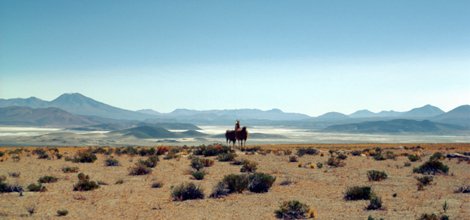 The
Andes stretch 5,500 miles along the west coast of South America and reach heights
of more than 22,000 feet, approximately twice as high as most large mountain
ranges. Researchers have long known that mountain building could influence climate
in the region. But two geoscientists now hypothesize that the link between climate
and mountain building in the Andes is a two-way street.
The
Andes stretch 5,500 miles along the west coast of South America and reach heights
of more than 22,000 feet, approximately twice as high as most large mountain
ranges. Researchers have long known that mountain building could influence climate
in the region. But two geoscientists now hypothesize that the link between climate
and mountain building in the Andes is a two-way street.Llamas roam the arid landscape of the Western Cordillera in the high Bolivian Andes, more than 4,000 meters above sea level. Geologists now speculate that climate might play an important role in controlling the mountains’ height. Photo courtesty of Simon Lamb.
In the Oct. 23 Nature, geologists Simon Lamb of Oxford University and Paul Davis of the University of California at Los Angeles suggest that climate is an important player in the subduction of the Nazca oceanic plate underneath the South American continental plate, controlling tectonic movement and the height of the Andes. While plate convergence certainly pushed the unbroken mountain chain upwards, the researchers say that process alone fails to explain the Andes’ prowess because many other mountain chains formed in similar fashion.
A Cenozoic cooling in the Pacific Ocean would have decreased the evaporation and subsequent rains in the Andes, Lamb says. Less rain means less sediment is eroded from the mountains and washed into the trenches of the plate boundary, which increases the friction in the subduction zone. The buckling that results has pushed the Andes to new heights, he says.
Lamb and Davis’ initial goal was to figure out what had caused the Andes to grow so tall. “Our postulated link with climate was a complete surprise,” Lamb says. “Who would have thought that a change in ocean temperature could set in motion a chain of events that led to the rise of a large mountain range?”
The researchers analyzed the force balances in the mountains, calculating the average shear stresses in the subduction zone needed to hold them up, Lamb says. During the study, they noticed that the largest subduction earthquake ever recorded took place in a sediment-rich part of the subduction trench, where there were low shear stresses. Lamb and Davis attribute this seismicity to sediment smoothing out the stress distribution and thus “lubricating” the plate interface and freeing up the earthquake rupture. Conversely, in the most arid sections of the Andes, where the peaks are highest, earthquakes are less frequent and less severe. Here, in the Central Andes, cool Pacific currents and wind-driven coastal upwellings keep near-shore temperatures low, Lamb says, and the Peru-Chile trench is virtually devoid of sediment.
The Central Andes is the only continental mountain range on the planet that lies adjacent to such a sediment-starved trench. Over a 1,000-kilometer stretch of coastline, virtually no rivers reach the sea, which is the primary reason there is so little sediment in the trench. “We believe this is the reason that the range is so much higher than all the others,” Lamb says. “The subduction zone is deprived of its lubrication and is much rougher than elsewhere.”
It would follow then, Lamb says, that changing climatic conditions would affect the tectonics and height of the mountains. “For example, if a long-term increase in the rainfall along the coast of northern Chile did occur, perhaps as a consequence of long-term global warming, then the high Andes would start to collapse and sink down because lubricating sediment would once again reach the trench and be carried down the subduction zone,” Lamb says. The recognition of such mountain ranges in the geological record could also indicate past climatic conditions. “If we are right, it’s pretty interesting. It seems to be the tail wagging the dog,” he says.
“Lamb and Davis have pulled together several interesting and already fairly well-known results into a thought-provoking package,” says Rick Allmendinger, a structural geologist at Cornell University in Ithaca, N.Y., who has been working in the Andes for 20 years. “I don’t think there is any doubt that there is a relationship between climate and uplift in the Central Andes,” he says. But, he says, the researchers need to further consider two mountain-building processes that most researchers believe to be important in building the Andes: arc magmatism and the mantle wedge between the two converging plates, which is widely thought to control the width of mountain ranges.
Lamb says that more research is certainly needed. The pre-Miocene climate along the west coast of South America is largely unknown, he says. Therefore, one important step forward is to more precisely document the Cenozoic evolution of the climate and sediment yields. He also wants to refine the general understanding of the Andes uplift history itself.
Megan Sever
Back to top

